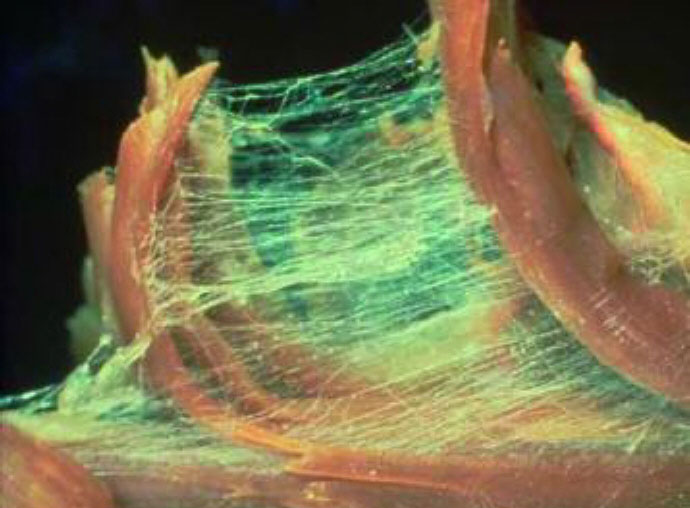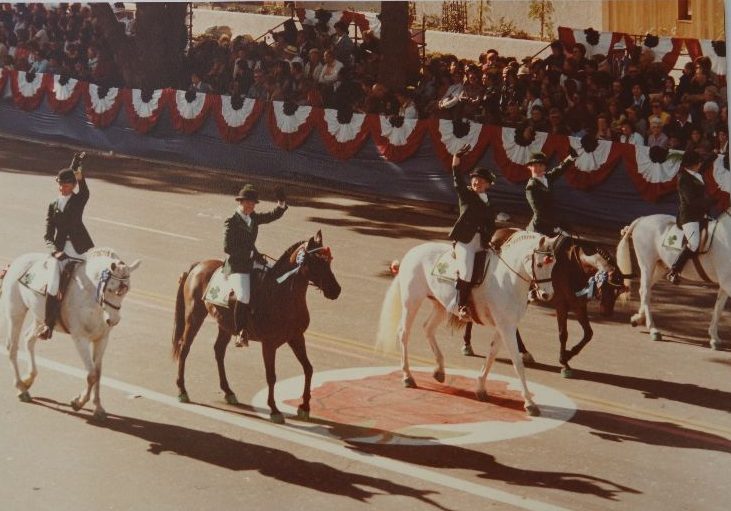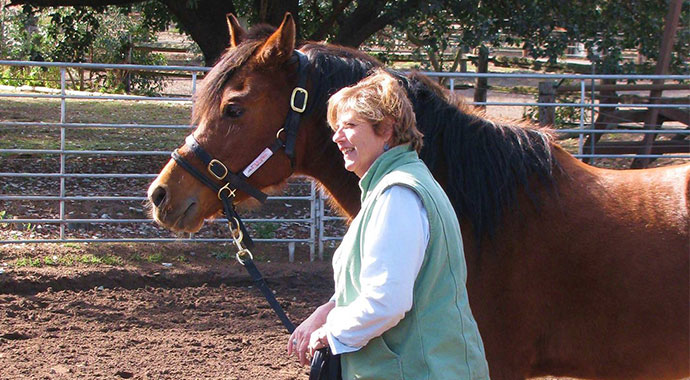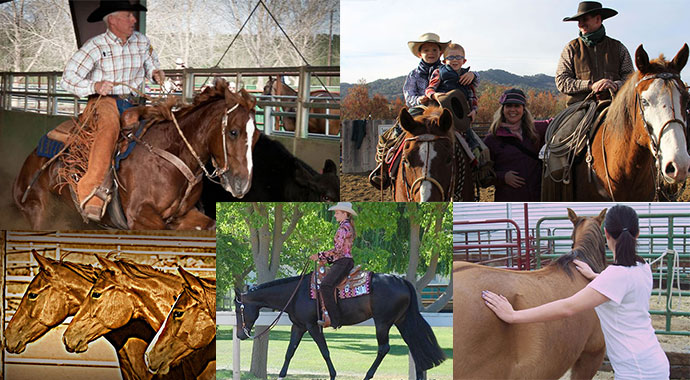Fascia is a continuous web of tissue that covers everything in our bodies. You’ve seen it when you lift the skin off of a piece of raw chicken. It’s that thin, translucent tissue that stretches between the skin and the flesh. It actually penetrates into the flesh.

Fascia covers everything in the body, muscle fibers, bone, organs, blood vessels, the spinal column and brain in the form of dura mater that is part of the craniosacral system, and every cell. Normally the fascia is elastic-like, flowing and moving with the body, but injuries, traumas, repetitive motion, even restricted movement (such as wearing a cast or sitting too long—or being confined to a stall) can cause ‘restrictions’ in the fascia—spots that toughen, thicken, or become ‘dehydrated.’
These restrictions inhibit the natural fluidity of the fascia as it supports the body and moves with the body, and is actually the cause of tight muscles. Picture this: every fiber of muscle is coated with fascia. For the muscle to work properly the fascial planes need to be able to slide over one another. A ‘restriction’ causes the fascia to lose its ability to glide and it sticks, preventing the muscle from working properly.

The Problem with Fascial Restrictions in Horses
Fascial restrictions in horses can be caused by injuries, restricted movement such as stall rest, using tie downs and draw reins, poor collection techniques, training in patterns, and training techniques that stress the horse.
According to research papers presented at the International Fascial Congress, the only therapeutic activity that releases fascial restrictions are sustained holding techniques that are applied by a trained therapist for a prolonged period of time—up to 5 minutes or longer. There are three main therapies that address the fascia: Rolfing, Myofascial Release, and Craniosacral Therapy, especially Biodynamic Craniosacral Therapy. There are other therapies that claim to address the fascia. With very few exceptions these therapies are not getting the appropriate results.
Why is the fascia important to an anxious horse?
There are four stages to the flight/fight response:
- Flight—run and escape;
- Fight—when flight doesn’t work, turn and fight and vanquish the threat;
- Freeze—flight and fight failed so now the body shuts down in surrender, or disassociates to avoid the awareness of what is happening;
- Thawing—the danger passes and we shake and tremble to discharge the flight/fight neurotransmitters.
You have probably noticed that when a horse in a field is startled, it runs for a short distance then stops and turns. Once it is satisfied the danger has passed a lone horse may appear to be playing—this behavior is especially present in a group of horses. Once they stop running they may continue to discharge neurotransmitters by playing with one another for a short time. They might also give themselves a big shake or lie down and roll. This is all part of the thawing (discharging) process.
The Freeze Response
The freeze response is most often manifested in the fascia. A horse with fascial restrictions from any cause can be anxious for a number of reasons: pain and discomfort, stiffness and tightness and not being able to move well, and the result of an injury or emotional trauma.
A classical example of why the fascia is important to an anxious horse is a sore back. Horses with this condition often move with their heads up and their backs hollow. What does a horse do when it goes on alert to a potential danger? It raises its head to see better and tenses its back in preparation for flight. So, what happens with a horse that is bracing against a painful or stiff back? It has assumed the posture of vigilance. Since this position is body language for “Run!” the flight/fight neurotransmitters fire and puts the horse on a higher alert … manifesting in nervousness or anxiety, or bolting (escaping).
Releasing Restrictions in the Fascia
Research results that have been presented at the International Fascial Congress, as well as the following results from the University of Miami, indicate that the fascia plays an important role in how cells process neurotransmitters. This bring us to the conclusion that releasing restrictions in the fascia, throughout the body, can have very positive influence on calming stress and anxiety.
- In humans, every one of our 75 trillion cells is surrounded by a fascial membrane. (Author’s note: I’m still trying to discover the number of cells in a horse’s body. We can be assured that, regardless the number of cells, every cell of the horse is also surrounded by fascial membrane.)
- Every cell is not only surrounded by fascia membrane, it is embedded in a vast living vibrating crystal matrix three-dimensional web of fascia. This fascia is the environment of every cell in our body. (Oschman J. Energy Medicine – The Scientific Basis. Edinburgh:Churchill-Livingstone, 2000.)
- Each cell functions by way of signals that come thru the cell membrane and stimulate the RNA and DNA of the cell to do what it is supposed to do. (Lipton B. Biology of Belief. Santa Rosa, CA: Mountain of Love/Elite Books, 2005.)
- When fascial restrictions develop not only is it difficult to move in alignment with good posture and function, cellular signals can’t get through the fascial membrane, and the body is more susceptible to germ attacks, unevenness in neurotransmitter flow, neuropeptides, hormones, steroids. (Pert, C Ph.D. Molecules of Emotion. NY, NY: Scribner, 1997.)
Carol M. Davis, DPT, EdD, MS, FAPTA, Professor Emerita
Department of Physical Therapy,
University of Miami Miller School of Medicine
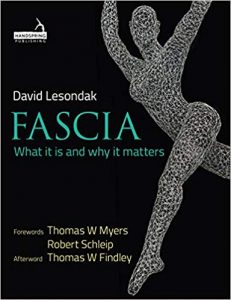 For more information on what Fascia is and why it matters, check out the book Fascia by David Lesondak. “Illustrated throughout in full color, this will be an ‘entry-level’ account of the structure and functions of fascia as presently understood. Designed for all therapists in the broad areas of bodywork and movement it will describe the nature and role of this all-pervading tensional network in the human body.”
For more information on what Fascia is and why it matters, check out the book Fascia by David Lesondak. “Illustrated throughout in full color, this will be an ‘entry-level’ account of the structure and functions of fascia as presently understood. Designed for all therapists in the broad areas of bodywork and movement it will describe the nature and role of this all-pervading tensional network in the human body.”
Clicking the above link takes you right to the book on Amazon. We do get a little kick-back from purchases made through this link. This provides us resources to to bring you more SLO Horse News stories, yet your price stays the same. It’s a win-win!

